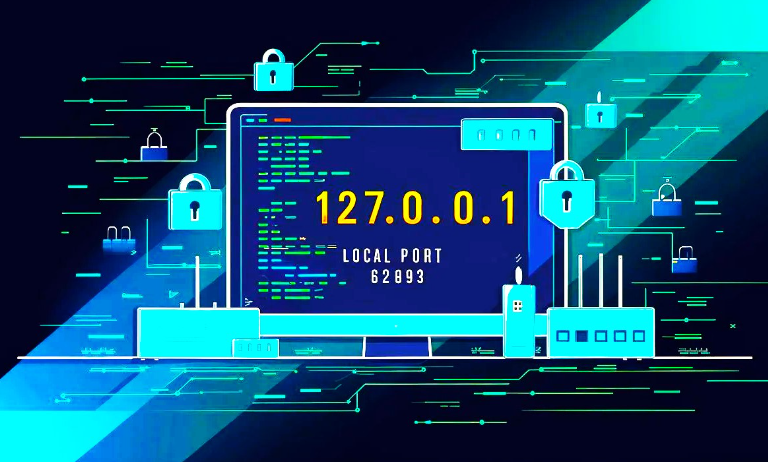In the realm of computer networking, 127.0.0.1:62893 stands as one of the most important and well-known IP addresses. It refers to the local loopback interface in IPv4 systems, essentially allowing a device to send messages to itself. This is particularly useful for testing and debugging purposes without needing external connections. When combined with a port, such as 62893, it enables specific applications to communicate internally within a computer system.
In this comprehensive guide, we’ll dive deep into the significance of 127.0.0.1, the functionality of port 62893, and how they work in tandem within various systems. By fully understanding these concepts, businesses and developers can improve troubleshooting, testing, and overall network management processes.
What is 127.0.0.1?
127.0.0.1:62893 is the loopback address that refers to the localhost of the device you are working on. Unlike standard IP addresses that communicate across different networks, the loopback address allows a computer to communicate with itself. When a program is set to access 127.0.0.1:62893, it doesn’t reach out to the network but rather loops the request back to the same machine.
This is particularly crucial when testing servers or services that need to operate in a self-contained environment before being deployed to a live network. It’s the default IP for many local servers, ensuring that developers can operate in a secure and isolated testing environment without involving external network resources.
How Does 127.0.0.1 Work?
When a device references 127.0.0.1:62893, the message is internally routed within the system. It bypasses the network interface card (NIC) and directly handles the communication within the machine itself. Any requests sent to this address are not broadcast across the network but are instead processed locally, thus reducing external network traffic and improving testing security.
The Role of Ports in Networking
Before diving into port 127.0.0.1:62893, it’s important to understand what network ports are. In networking, a port is a communication endpoint. Applications running on a computer or a server often communicate with each other or external systems via these ports.
Ports are numerical labels that identify specific services or applications running on a system. For example, port 80 is used by HTTP, and port 443 is reserved for HTTPS traffic. There are 65,535 possible ports, and each is designed to handle a different type of network communication. Ports are categorized as either well-known ports (0-1023), registered ports (1024-49151), or dynamic/private ports (49152-65535).
Port 62893: What It’s Used For
Port 62893 falls into the category of dynamic or private ports, which means it isn’t assigned to any specific service by the Internet Assigned Numbers Authority (IANA). These ports are often used for temporary, ephemeral connections that applications create dynamically to communicate.
While port 62893 itself does not have a well-known service associated with it, it is commonly utilized in custom or proprietary applications. For instance, developers may configure their local development environments or specific services to run on this port when testing within the 127.0.0.1:62893 loopback interface. This is particularly useful in development, where multiple services need isolated environments to function without interference.
Security Considerations for Port 62893
When running services on dynamic ports like 62893, it’s essential to ensure that they remain secure, especially if the application in question could potentially be exposed to outside networks. Although local testing on 127.0.0.1:62893 typically does not pose any external threat, once the application is deployed, firewalls and security protocols should be in place to mitigate any unauthorized access.
Common Use Cases of 127.0.0.1 and Port 62893
Many developers and system administrators rely on the combination of 127.0.0.1 and custom ports like 127.0.0.1:62893 for a variety of use cases, including:
1. Testing Web Applications
When testing web servers or applications, it’s common to set them to listen on 127.0.0.1 along with a specific port (such as 62893). This setup allows developers to simulate real-world environments where different applications or services must communicate internally without exposing sensitive information or data to external traffic.
2. Running Databases Locally
Databases like MySQL or PostgreSQL can be set up to listen on the localhost address, with ports like 127.0.0.1:62893 being assigned to specific database instances for internal testing purposes. This allows seamless integration testing without the need for external hosting.
3. Debugging Network Applications
Network application developers often use 127.0.0.1:62893 in conjunction with ports like 62893 to isolate and debug issues. Since loopback traffic does not leave the device, it ensures a controlled environment for identifying problems without introducing external network variables.
4. Custom Application Development
Custom-built applications, especially during early stages of development, are frequently tested on 127.0.0.1 and a dynamic port like 62893. This approach allows developers to easily simulate server-client interactions in a safe, local environment.
How to Set Up and Use 127.0.0.1:62893
Step 1: Configuring Localhost with Port 62893
Setting up a service or application to run on 127.0.0.1:62893 is relatively simple. In most programming environments or server configurations, you can manually specify the IP address and port number for a service.
Step 2: Testing with 127.0.0.1 and Port 62893
After configuring the service, you can access the application by entering 127.0.0.1:62893 in your web browser. Because this is a loopback address, it won’t be accessible from outside networks, ensuring a safe testing environment.
Conclusion
Understanding the relationship between 127.0.0.1:62893 and dynamic ports like 62893 is critical for developers, system administrators, and network engineers alike. By leveraging the loopback interface and custom ports, internal testing can be done securely and efficiently without exposing systems to the risks associated with external network traffic.
Mastering this concept allows for better application development, faster debugging, and more secure network testing environments. With the right configurations and security measures in place, 127.0.0.1:62893 can be a powerful tool in any developer’s arsenal.



